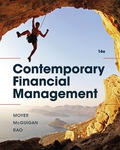
Concept explainers
a.
To discuss: The definition of nonvoting stock associated with common stock.
a.
Explanation of Solution
The definition of nonvoting stock associated with common stock is as follows:
A nonvoting stock that gives the investor practically zero decision on corporate issues, for example, mergers or the appointment of the directors. Such type of share may speak to investors who need to receive benefits from an organization's performance yet are less investing impacting its path.
b.
To discuss: The definition of stock split associated with common stock.
b.
Explanation of Solution
The definition of stock split associated with common stock is as follows:
A stock split happens when a corporation recollects its shares outstanding and issues more than one offer for each beforehand share outstanding. At the end of the day, the corporation takes the shares outstanding the investors claimed, and the splits them into a bigger number of shares despite everything keeping up a similar total worth. It is likewise called as a forward stock split
c.
To discuss: The definition of reverse stock split associated with common stock.
c.
Explanation of Solution
The definition of reverse stock split associated with common stock is as follows:
A reverse stock split is a decrease in the quantity of an organization's shares outstanding in the market. It is regularly founded on a fixed ratio.
d.
To discuss: The definition of stock dividend associated with common stock.
d.
Explanation of Solution
The definition of stock dividend associated with common stock is as follows:
A stock dividend is a technique utilized by organizations to allocate capital to investors, it is made through dividend payment through shares instead of paying in cash. Stock dividends are essentially given instead of cash dividends when the organization is low on liquid cash available.
e.
To discuss: The definition of book value associated with common stock.
e.
Explanation of Solution
The definition of book value associated with common stock is as follows:
Book value is the equity value of the company which is stated in the financial statement of the company. The book value figure is normally seen corresponding to the organization's stock worth and is dictated by taking the total value of an organization's assets minus any of the liabilities if a company be indebted.
f.
To discuss: The definition of
f.
Explanation of Solution
The definition of treasury stock associated with common stock is as follows:
A treasury stock is generally a corporation's recently issued shares of common stock that have been bought from the investors, however the organization has not resigned the shares. The total number of shares of treasury stock is the contrast between the total number of shares gave and the total number of shares that are outstanding.
Want to see more full solutions like this?
Chapter 7 Solutions
EBK CONTEMPORARY FINANCIAL MANAGEMENT
- Which of the following are not part of common equity? a. preferred stock c. retained earnings b. common stock d. treasury stockarrow_forwardWhat information do you need to calculate the weighted average common shares outstanding?arrow_forwardWhich of the following decreases total equity? A. A stock split B. Recording Revenue C. The purchase of Treasury Stock D. Issuance of Convertible preferred stockarrow_forward
- Stock and dividend returns can be shown in percentage, dollar, and per-share values. True or Falsearrow_forwardTreasury stock is generally accounted for by the * cost method. O market value method. O par value method. O stated value method.arrow_forwardDifferentiate between the stock dividend and stock split and their effects on the stock prices.arrow_forward
- A stock's par value refers to the: O A. Issue price of the stock. O B. Value assigned per share by the corporate charter. O C. Market value of the stock on the date of the financial statements. D. Maximum selling price of the stock.arrow_forwardTreasury stock should be reported as: a. A Reduction of stockholders equity in the balance sheet b. A Fixed asset in the balance sheet c. A long term investment in the balance sheet d. A Current asset in the balance sheetarrow_forwardDistinguish between common stock and preferred stock,and explain the difference between market value andintrinsic valuearrow_forward
- The Stockholders' Equity section of the balance sheet may include which of the following? Group of answer choices Common Stock Preferred Stock Retained Earnings Common Stock, Preferred Stock, Retained Earningsarrow_forwardWhat are the differences between common stocks and preferred stocks in terms of the rights of stockholders and dividend characteristics?arrow_forwardIndicate how each of the following accounts should be classified in the stockholders’ equity section. a. Common Stock. b. Retained Earnings. c. Paid-in Capital in Excess of Par—Common Stock. d. Treasury Stock. e. Paid-in Capital from Treasury Stock. f. Paid-in Capital in Excess of Stated Value—Common Stock. g. Preferred Stock.arrow_forward
 EBK CONTEMPORARY FINANCIAL MANAGEMENTFinanceISBN:9781337514835Author:MOYERPublisher:CENGAGE LEARNING - CONSIGNMENT
EBK CONTEMPORARY FINANCIAL MANAGEMENTFinanceISBN:9781337514835Author:MOYERPublisher:CENGAGE LEARNING - CONSIGNMENT Cornerstones of Financial AccountingAccountingISBN:9781337690881Author:Jay Rich, Jeff JonesPublisher:Cengage Learning
Cornerstones of Financial AccountingAccountingISBN:9781337690881Author:Jay Rich, Jeff JonesPublisher:Cengage Learning Intermediate Accounting: Reporting And AnalysisAccountingISBN:9781337788281Author:James M. Wahlen, Jefferson P. Jones, Donald PagachPublisher:Cengage Learning
Intermediate Accounting: Reporting And AnalysisAccountingISBN:9781337788281Author:James M. Wahlen, Jefferson P. Jones, Donald PagachPublisher:Cengage Learning- Principles of Accounting Volume 1AccountingISBN:9781947172685Author:OpenStaxPublisher:OpenStax College





